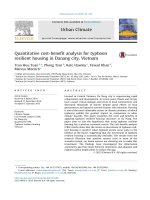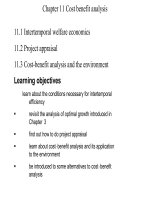Applied welfare econ cost benefit analysis ch9
Bạn đang xem bản rút gọn của tài liệu. Xem và tải ngay bản đầy đủ của tài liệu tại đây (74.82 KB, 16 trang )
Applied Welfare Econ & Cost Benefit Analysis
Chapter 9
Existence Values
Existence value
Purpose: To define existence value (as a
benefit category) and discuss the theoretical
and empirical problems CBA analysts face
when using it.
ACTIVE AND PASSIVE USE VALUES
Social benefits are measured (comprehensively)
through people's Willingness-to-Pay (WTP).
This is usually derived from observation of people’s
behaviors (such as changes in consumption).
In some situations, however, people are willing to
pay for something they don’t “consume.”
Measuring such “existence” value is more difficult.
ACTIVE AND PASSIVE USE VALUES
Active use – person makes some nonrivalrous
use of the object in question (e.g. hiking in the
wilderness).
Passive use or non-use – person values good
not actively used (e.g. thinking about
existence of wilderness).
Non-use value – people are willing to pay
even though they don’t use it.
ACTIVE AND PASSIVE USE VALUES
Non-use value is not easy to define. There are a
number of complications.
First, it is sometime difficult to determine if a
good has non-use value.
People can derive both use and non-use from
an asset. It is difficult to separate the non-use
value and use value components from the
individual’s total WTP.
ACTIVE AND PASSIVE USE VALUES
Non-use value is not easy to define. There are a number of
complications.
One can try to first determine the WTP for the use and then
separately find the WTP for non-use (or vice versa), and then
add the two together for total WTP.
However, the order (i.e. whether use or non-use comes first)
typically yields different classifications of the same total
WTP. (Appendix 9A provides an illustration.)
Second, non-use value cannot be directly observed, only
discovered through stated preferences.
ACTIVE AND PASSIVE USE VALUES
Specific active use benefit categories:
Rivalrous consumption goods: value is easily
determined through markets.
Direct nonrivalrous consumption: consumption is on
site and can usually be observed.
Indirect nonrivalrous consumption: consumption is
offsite (a book or movie about something) and also
may be observable.
ACTIVE AND PASSIVE USE VALUES
Specific passive use benefit categories:
Option value: value to keep open the possibility of
use in the future.
Pure existence value: good has intrinsic value apart
from use value.
Altruistic existence value: driven by desire for
others to consume the good.
Bequest value: altruism is directed toward future
generations.
Total Economic Value
Non-use value
Use value
Actual
use
Option
Value
For
others
Altruism
Existence
Bequest
MEASURING EXISTENCE VALUE
Directly eliciting total value can be derived
from direct surveys
Respondents state their WTP based on all
their possible motivations for valuing policy
changes.
This approach depends on the analyst’s ability
to frame correct questions, and requires the
analyst to convey a full description of the
policy in question
MEASURING EXISTENCE VALUE
Eliciting altruistic existence values poses
special problems...
For an individual’s own consumption, cost
and benefits can be estimated separately and
then added together to obtain net benefits
Altruistic values, however, may depend on the
distribution of costs and benefits: who will
use the good and who bears the cost of
maintaining it?
MEASURING EXISTENCE VALUE
If the above concerns are addressed and
if the sample of individuals interviewed
includes all the people with standing,
then the valuations would complete the
CBA
Often, however, only a sample of people
are interviewed to supplement direct
observation of use value.
MEASURING EXISTENCE VALUE
As WTP of use and non-use values are sensitive to
the order in which they are valued, use values should
normally be discovered before non-use values, or
else non-use will be overestimated.
Non-use values are also sensitive to geographic areas
(i.e., higher existence values for assets in closer
proximity). Therefore, the extrapolation of samples
over a large geographic area is controversial.
MEASURING EXISTENCE VALUE
Also, if respondents are informed of all
sources of uncertainty relevant to the
valuation of the policy change, then WTP
becomes an option price => no adjustment for
uncertainty is required.
BUT SHOULD EXISTENCE VALUE BE
INCLUDED IN CBA?
Although existence values for unique and
long-lived assets should be estimated
whenever possible, costs and benefits should
be presented with and without their inclusion
to make clear how they affect net benefits
When existence values can’t be measured, the
analyst should discuss their possible
significance on the sign of net benefits.
NEXT
Direct Valuation
READ CHAPTER 12









